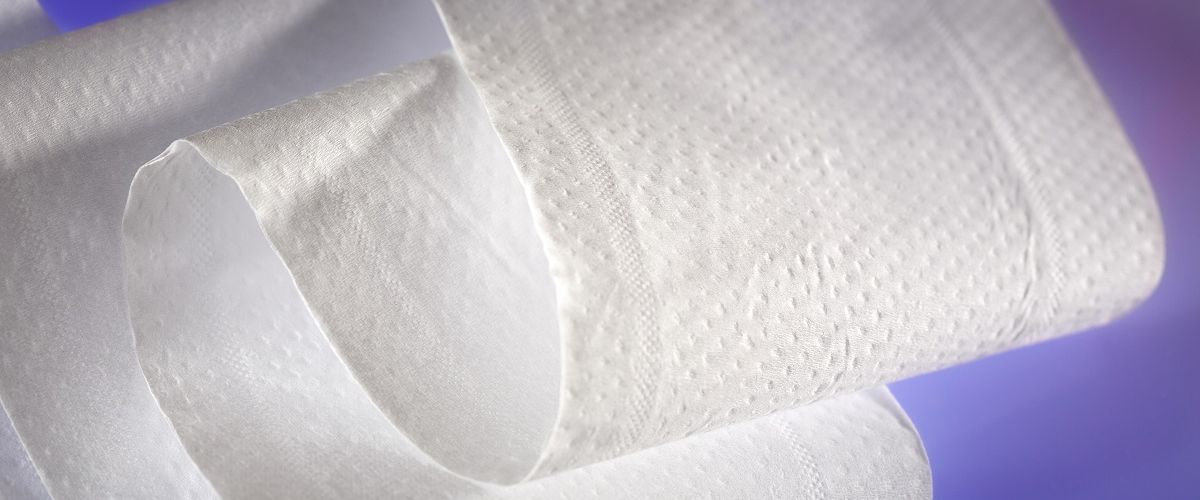
Common Definitions in the Tissue Industry
Jargon is used within just about any industry and is often confusing to newcomers. The tissue market is not excluded. The following is a list of common terms and definitions used within the tissue industry by operators, management, and vendors.
Absorbency - The amount of water a sample will absorb in a given time or the time to absorb a given amount of liquid. Important for retail towel production.
Air side - The side of the sheet that is exposed to the hood air during the drying process.
Basis weight - Sometimes called the grammage or substance, this is the weight (mass) per unit. In Europe, this is normally expressed as grams per square meter, gsm, or g/m2. The weight in pounds of a ream of paper of a basic size, usually 25 × 38 inches (63 × 96 cm) for book stock, 17 × 22 inches (43 × 55 cm) for writing stock, and 20 × 26 inches (50 × 66 cm) for cover stock.
Brightness - The measure of whiteness or lack of other colors in the sheet.
Bulk - The total thickness of eight sheets as measured and expressed in mils or microns.
Cases - Converting operations measure their production in cases produced. The case unit will vary in size by brand and grade.
CD tensile - Cross machine direction tensile strength.
Chatter - To vibrate during cutting to produce surface flaws on the work. Damage in the Yankee surface from the doctor blade not riding smoothly in the Yankee coating.
Cleaning doctor - This doctor is not installed on all machines and is used to clean the coating off the Yankee before the chemistry addition with the spray boom shower.
CMC - Carboxymethylcellulose. A white, water-soluble polymer derived from cellulose, used as a coating and sizing for paper and textiles. Used for dry strength and as a charge scavenger in high dosage wet strength towel processes. Negatively charged product.
Creping - Crinkling of paper during drying to produce a soft, elastic sheet – giving the tissue added thickness and absorbency. The collision the paper sheet on the Yankee has with the creping blade. This action on the sheet will produce more bulk and reduce the strength of the sheet. As the intensity of this collision increases, a sheet with higher softness and more bulk will be produced.
Crepe count or CBI - Crepe bars per inch. The counting of the surface bars on the Yankee side of the sheet.
Creping doctor - The main doctoring unit on the machine where the tissue is creped.
Crepe ratio - Dryer speed/reel speed
Crosslinking adhesive - A low pH adhesive that reacts quickly and forms a thin, hard film and will not rewet. Wet strength resin is an example of a crosslinking polymer.
Cut-off or skinner doctor - The doctor blade above the creping blade. It is loaded when the creping doctor blade is changed.
Dead cat adhesive - A neutral pH adhesive that will not crosslink and is rewettable.
Dirt count - The count or measurement of the total amount of dark materials embedded in the tissue sheet.
Dispersability or flush test - Finished products are tested to see how quickly they break up when subjected to water and shear. Important for all bath tissues.
Dry strength - Tensile strength enhancement product. Glyoxyalated Polyacrylamide (GPAM) fed at a pH of 6 to 9. Starches and CMC are other dry strength products.
Dusting - The debris or dust that falls from converted tissue; a critical issue for bath and facial tissue.
eTAD - Technology developed by Georgia-Pacific. It is a hybrid dry crepe process that uses a TAD-type fabric to add structure to the sheet to make a more absorbent towel from recycled fibers.
Extender - A substance added to another substance to increase its volume or bulk. Polyvinyl alcohol (PVOH), Polyvinylpyrrolidone (PVP) or other low cost molecules that add some nature of adhesion or film forming to the spray on chemistry. Extenders are always used when Through-Air Drying (TAD) technology is used.
Hand feel - A panel of experts tests a sample and rates the tissue softness according to existing standards.
Hard coating - A thin, quick-setting coating that uses a crosslinking adhesive.
Imperial basis weight ream size - The imperial measurement of ream size in tissue is pounds/3000 square feet. The metric measurement is grams per square meter (gsm). To convert imperial units to metric units, divide by 0.6.
MAP - Monoammonium Phosphate. A white, crystalline, moderately water-soluble compound. A low pH source of phosphate for creping chemistry is typically fed as a 20% active product.
MD tensile - Machine direction tensile strength.
MDS or stretch - Machine direction stretch is the length the sheet stretches before it breaks in the MD tensile test. Expressed as a percentage.
Modifiers - Non-oil products added to the spray boom shower to change or modify the nature of the film developed by the adhesive. The modifier film will react faster and be thicker than films created by an oil release.
Operational definitions - These terms are used by operations personnel to describe the equipment, processes, and products used in tissue manufacturing.
Percent crepe - Yankee speed-reel speed divided by Yankee speed. A high-quality bath can be 25%.
Phosphates - A salt or ester of phosphoric acid, such as Monoammonium Phosphate (MAP) or Tetrapotassium Pyrophosphate (TKPP), used to prevent corrosion and promote adhesion when added to the spray boom shower. Typically used on metalized Yankee surfaces.
Pilling - A negative side effect to bath tissue when it is wetted and pieces stick to the end user. This test is important to high-end bath tissue producers.
Plasticizer - A group of substances used in materials to impart viscosity, flexibility, softness, or other properties to the finished product. Additives that increase the plasticity or fluidity of a material. A glycerin-based product used to soften harder adhesive films.
Release - The lube that helps the sheet release at the blade and provides lubrication for the creping process. These products are usually mineral oil-based and are key in preventing fires after blade changes.
Rewettable adhesive - A soft adhesive that will not crosslink and can be removed from the Yankee dryer with excess water or moisture streaks.
Sheet flying or loose - The sheet is poorly attached to the Yankee before blade and chemistry changes need to be made.
Sheet tight - The sheet is not releasing from the blade and release needs to be added or adhesive reduced to properly control the sheet.
Soft coating - A thick coating film that is soft and rewettable.
Spray Boom Shower - The shower used to spray the chemicals on the Yankee. Typically a 2 to 3% strength solution preheated to 110°F to 130°F is used. This shower typically uses a double or triple overlap and can add up to 10% of the drying load with the water added.
Strength related chemistry - These chemistries are used to add a functional property to the sheet that cannot be produced through the creping process. Wet strength is important to towels and napkins and is not developed without the additional strength chemistries.
Temporary wet strength - A GPAM polymer. A low solids product with a short shelf life. Used in low pH (5 to 7) systems. Common in high-end bath tissue to reduce pilling.
Tensile strength - The maximum stress a material can withstand while being stretched or pulled before failing or breaking. The resistance of a material to longitudinal stress, measured by the minimum amount of longitudinal stress required to rupture the material. The strength required to pull a test strip apart. The units vary but most will be ounces/3 inches, grams/3 inches, grams/1 inch or 25 mm.
Through Air Drying (TAD) - A process for tissue drying with the paper web running over a perforated drum where hot air is blown through the web. Some TAD tissue papers are made without creping (un-creped through air drying- UCTAD). In addition, most machines incorporate a transfer from high-speed to low-speed rolls, which can have a similar effect as creping. Some TAD tissue papers are crepe finished using TAD machines which include a Yankee dryer. The bulk and functional properties are dependent on the type of TAD fabric and fibers used in the process. Yankee creping has little effect on the development of the sheet produced.
UCTAD - A TAD process without a Yankee.
Wet/dry strength ratio - The ratio of the wet tensile strength/dry tensile strength, typically expressed as a percentage. Important in retail towel production.
Wet strength resin - A low pH (3 to 5) polymer that will crosslink as the pH rises and dries. The bonding with the fibers is permanent. This next section of terms and definitions are functional properties or characteristics important for: softness or hand feel (see definition below) in bath or facial tissue; dry strength in all products; temporary wet strength for high end bath tissue; wet strength in bath, towel and napkin grades; getting the packaging to fit properly; brightness and dirt count for visual standards; and the end users.
Wet tensile strength - Tensile strength after curing the sheet and wetting the strip. Cure at 105°C for five minutes. TAPPI STD T 456. Important to towel manufacturers.
Yankee adhesive - The glue or stick added in the spray boom shower to make the tissue develop a desired characteristic.
Yankee basis weight - Actual sheet weight before creping occurs. Reel weight with the creping backed out or reel basis weight multiplied by the reel speed divided by the Yankee speed.
Yankee chemistry, adhesives, and related chemicals - Yankee chemistry refers to a particular material sprayed directly onto a Yankee dryer. The Yankee chemistry is used to achieve functional properties of the tissue and towel, and have a large impact on the production process. Yankee chemistry including adhesives, modifiers, releases, phosphates, and extenders are all typically sprayed directly onto a Yankee dryer by a spray boom shower.
Yankee coating - The material attached to the Yankee shell which is usually a haze or white build-up that makes a fine dust when removed.
Yankee dryer - A large, steam-heated, pressure vessel used in the production of tissue grades. Two critical operations occur at the Yankee dryer: (1) the sheet of the tissue is dried to its final moisture target and (2) it is creped by the creping doctor.
Yankee modifiers and releases - Yankee chemistry has three major functions for tissue production: protection of the Yankee from wear, proper adhesion at the blade to provide the required crepe structure, and allowing the sheet to be removed from the Yankee in the desired form. Without the proper mix of chemistries sprayed on the Yankee, the sheet at the creping blade would be nothing but debris.
Yankee side - The sheet side attached to the Yankee before creping and is typically the softest.
Let’s Connect
Connect with Kadant Solutions Division on LinkedIn to learn more about our employees, products, and services.
